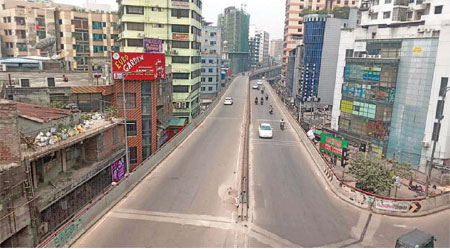
Selim Khan
Many people have fond memories of Eid holidays in Dhaka city. They appreciate the absence of traffic jams, crowded streets, noise and overall tranquillity, which is a sharp contrast to the usual hustle and bustle of the capital. During Eid, it is easier to find transportation, and there is less haggling with rickshaw or CNG drivers. Ride-sharing services are also readily available.
However, some people face challenges when drivers and domestic helpers take time off during this period.
We want to live in a city like this throughout the year but that does not happen. This city is home to everyone, from billionaire business persons to low-paid office assistants. Such an example is rare worldwide, and there is a sense of pride in this coexistence. However, while these rights are protected, the suffering of low-income people is steadily increasing.
Much of their income is spent solely on house rent and transportation expenses. Meeting the cost of electricity, water, and children’s education is challenging. In the event of any major illness, borrowing money has become a norm. These harsh realities are intertwined with the lives of the lower-income groups.
 According to the 2022 census, more than 12 million people live in Dhaka’s two city corporation areas. This number is expected to be even higher due to the temporary migrants from all over the country who may not have been counted. Dhaka Mega City, as defined by RAJUK, is home to over 20 million people.
According to the 2022 census, more than 12 million people live in Dhaka’s two city corporation areas. This number is expected to be even higher due to the temporary migrants from all over the country who may not have been counted. Dhaka Mega City, as defined by RAJUK, is home to over 20 million people.
According to the World Economic Forum forecast, the population of Dhaka will reach around 32 million by 2035. Can anyone imagine an increase of more than 10 million people in Dhaka during this period? Where will the resources for housing, food, water, sanitation and transportation for this huge number of people come from?
Somewhat unplanned, the capital Dhaka is suffering from obesity today, just like the lower-income people suddenly becoming rich. All family members are affected by obesity by eating unaccounted food, as a result of which thousands of diseases have settled in their bodies. Since the price of land in and around Dhaka has skyrocketed for a long time, “Aladdin’s magic lamp” has been found in the hands of a group of people.
But who bears the brunt of this overcrowded city? Dhaka is ranked as one of the most unliveable cities, yet the cost of living is among the highest. Those living in Dhaka spend much time sustaining their lives yet experience the harsh reality of poor living conditions.
In this city, a system has been created where lower-income individuals bear the burden of extra expenses and endure inhumane living conditions. Meanwhile, the wealthy need help with the civic comforts they desire within the city, leading them to seek opportunities abroad. As a result, the financial burden impacts people from all income groups, forcing them to live in a town lacking proper civic amenities.
The root of this issue lies in the government’s policies. The role of the government is crucial in addressing the Dhaka-centric nature of everything. With improved communication, Dhaka can now be reached within 12-14 hours from remote areas, and air travel has become more accessible.
Urbanisation is growing worldwide, bringing the comforts and conveniences of city life to even remote villages. As a result, many of our 180 million citizens seek city life for themselves and their children. This trend will inevitably continue, so increasing the supply is essential to meet the growing demand. The first step to improving this supply is to halt Dhaka’s overgrowth. This is not just a temporary pause; it requires a complete stop. To reiterate, Dhaka’s growth ends here.
Take a look at New Delhi, the capital of India. Surrounding it are cities like Noida, Ghaziabad, and Gurugram (Gurgaon) that have seen significant development. The communication system between Delhi and these cities has been designed to ensure a seamless connection, with many residents finding these neighbouring cities more comfortable than Delhi.
Shifting focus to Kolkata, people arrive by train and bus in the mornings, while the town empties in the evenings. It is estimated that around 10-15 million people outside Kolkata visit the city daily. Thanks to an efficient railway system, many low-income individuals can lead healthy lives without leaving their houses. Our shortcomings or failures are here.
There are no major cities near Dhaka. Narayanganj is known for its prosperous trade and commerce history, but it differs from Dhaka. Similarly, Savar can be a popular choice. Dhamrai and Manikganj are typical small towns, and Gazipur, while experiencing growth due to industries like ready-made garments, still needs more civic facilities. Gazipur is now the largest city corporation in the country, and Tongi has been merged with it. Bikrampur, now known as Munshiganj, was a prosperous area near Dhaka. But what even is there?
However, the solution is not only to build a few big cities next to Dhaka. We must develop divisional cities like Khulna, Mymensingh, Rangpur, Barisal and Rajshahi, as well as district headquarters to encourage people to live there. The only way is to remove the older characters of these cities and make them suitable for modern civil life. This will not only result in a more comfortable living environment for the residents of Dhaka but also enable them to enjoy happiness and comfort throughout the year rather than just during a few days of Eid.
_______________________________________
The writer is Executive Editor of Digital Media, Independent Television

